PELELIU SECURED IN COSTLY AMPHIBIOUS OPERATION
Peleliu, Palau Islands, Western Pacific Ocean • November 27, 1944
On this date in 1944, after 74 grueling days Peleliu was declared secure, although isolated pockets of Japanese resistance took many more days to exterminate. The battle for the island, ironically codenamed Operation Stalemate II, turned out to be the costliest amphibious operation in U.S. history: 2,336 Americans out of nearly 48,000 servicemembers who took part in the invasion lost their lives. American wounded numbered 8,450. A staggering 10,695 Japanese perished on Peleliu and surrounding islands. Between 200 and 300 Korean and Okinawan forced laborers survived the carnage as did 19 Japanese soldiers.
The U.S. decision to capture Peleliu Island was reached jointly by President Franklin D. Roosevelt, Adm. Chester Nimitz, Commander Pacific Ocean Area, and Gen. Douglas MacArthur, Supreme Commander Southwest Pacific Area. The 2 military chiefs frequently argued over the allocation of scarce resources in the Pacific Theater. Month by month Nimitz’s successful island-hopping across the Central Pacific had shrunk Japan’s Absolute Defense Zone, that country’s last-ditch oceanic defensive perimeter. MacArthur’s advance from New Guinea north toward the Philippines had the same effect. It now remained for Roosevelt, as U.S. commander in chief, to decide the strategic next step: either capture Formosa (Taiwan), the large island off the Chinese mainland prior to moving against Okinawa, seen as an essential U.S. staging area for the invasion of the Japanese Home Islands, or retake Japanese-occupied Philippines and afterwards assault Okinawa. Nimitz favored striking Formosa first, MacArthur the Philippines. At a July 1944 meeting attended by all 3 senior participants and their staffs in Hawaii, Roosevelt came down on the side of MacArthur, with Nimitz offering to protect MacArthur’s right flank during the coming offensive.
There was a problem though: the tiny coral islands of Peleliu (20 sq. miles/52 sq. km in size with a working airstrip) and nearby Angaur, 2 among roughly 100 islands in the Western Pacific Palau Islands chain, lay 600 miles/965 km to the east of the Philippines. Garrisoned by nearly 11,000 Japanese warriors in well-crafted fortifications of rocky caves and interconnecting tunnels, the twin specks of land posed a serious threat of aerial attacks against U.S. troop transport and supply lines to the Philippines. Both Maj. Gen. William Rupertus of the 1st Marine Division and Maj. Gen. Paul Mueller of the U.S. Army’s 81st Infantry Division predicted the quick capture of Peleliu. In a pre-invasion briefing Rupertus told his men Peleliu would be a 3‑day “cakewalk.”
It was anything but. Veterans of campaigns on Guadalcanal (August 1942 to February 1943) and Cape Gloucester (December 1943 to January 1944), the 1st Marine Division came ashore at the south end of Peleliu Island on September 15, 1944. Marine casualties on D‑Day approached 1,300, setting the tone for fighting on Peleliu over the next 2 months. Using a combination of flamethrowers, hand grenades and demolition charges, bazookas, M4A1 Sherman tanks, and rocket-firing (later napalm-dropping) aircraft, Marines strove to overcome well-organized Japanese strongpoints. On D+2 three battalions of the 5th and 1st Marine Regiments occupied the island’s operational airfield. (It was thought Peleliu’s airfield would play a vital role in airstrikes on enemy territories and the Home Islands; instead, the Mariana Islands of Saipan, Tinian, and Guam northeast of Peleliu did.) Japanese gun emplacements forced Marines to blast their way past fanatical defenders in their well-concealed strongholds of reinforced concrete pillboxes, caves ranging from small to monster-size caverns (over 500 of them), and an elaborate tunnel system. It all devolved into a bloodbath. Fifty‑four-year-old Marine general Rupertus, an old-school leatherneck, owned up to his role in the carnage, saying: “You can’t make an omelet without breaking the eggs.”
The Meat Grinder That Was Peleliu, September 15 to November 27, 1944
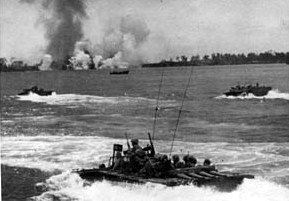 | 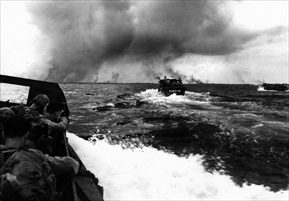 |
Above: U.S. Marines aboard amphibious warfare vehicles (amtraks) and landing craft head toward Peleliu’s beaches. Peleliu’s defenders had laid wire-controlled explosives around the island similar to laying minefields except these explosives were aerial bombs adapted for a defensive purpose. Luckily the intense pre-invasion naval and air bombardment had cut many of control wires, rendering some explosive devices useless. Even devices that were still intact failed to detonate, chiefly because their operators had been blinded by smoke.
 | 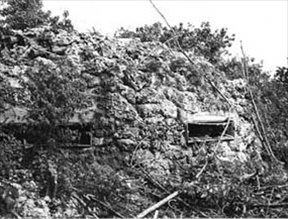 |
Left: At 8:32 a.m. on September 15, 1944, just 2 minutes behind schedule, 3 U.S. Marine Corps infantry regiments—the 1st, 5th, and 7th—of the veteran 1st Marine Division began landing on Japanese-held Peleliu. Depicted in this photo is one of the first waves of Marines, here seen hugging a sandy beach shaded by jungle and coconut palms in the southwest corner of Peleliu while awaiting orders to move inland. This first wave was preceded by armored amphibian tractors (LVTAs) mounting 75 mm howitzers. The LVTAs were meant to neutralize enemy artillery positions or other nasty strongpoints missed by previous naval and air bombardment. Less than 2 weeks later the earlier waves were followed by the division’s artillery regiment, the 11th Marines, and by soldiers of the U.S. Army’s 81st Infantry (“Wildcats”) Division after they had taken Angaur Island.
![]()
Right: A Japanese gun emplacement on Peleliu, September 1944. At this stage in the Pacific War Japanese defenders had perfected their fukkaku tactics (“endurance engagements”), which avoided high-cost, wasteful “decisive engagements” characterized by, for example, the infamous banzai charge. Americans looked upon Japanese banzai charges as opportune moments to wipe out large numbers of the enemy in short order. Fukkaku tactics envisioned a war of drawn-out attrition that would exact a terrible toll on enemy invaders for every bit of turf they gained. To great effect, Japanese army and naval personnel used natural features on Peleliu to construct pillboxes and bunkers amid coral ridges and rock outcroppings. They also made excellent use of natural caves, enlarging them to provide cover for hundreds of fighters. Fukkaku reduced the American advance on Peleliu to a bloody crawl. After Peleliu the Japanese used the drawn-out fukkaku stratagem in every island encounter they had with Allied soldiers and Marines. Only Shōwa Emperor Hirohito’s “Rescript on the Termination of the War,” broadcast to his subjects on August 15, 1945, dissuaded his countrymen from applying the fukkaku stratagem on Japan’s American victors later in the year.
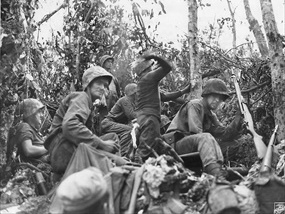 | 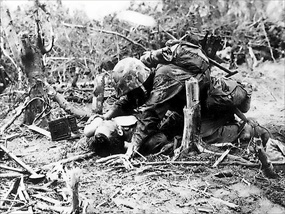 |
Left: During one of many close-quarter engagements in the dense jungle of Peleliu, a Marine hurls a Molotov cocktail (arm raised center in photo) toward crack enemy soldiers along a bitterly contested elevation nicknamed “Suicide Ridge.” George Peto, a sergeant in Lewis B. “Chesty” Puller’s 1st Marine Regiment, said after an encounter with the fire-breathing colonel, who hobbled around the battlefield on a swollen leg: “I would have followed that man to hell and that is exactly what we did on Peleliu.” That adoring sentiment wasn’t shared by many battle-weary leathernecks in Puller’s regiment; quite a few never forgave their commander for the horrific losses they sustained in Puller’s version of repeated and fruitless banzai charges on well-concealed Japanese redoubts on Umurbrogol Mountain, blanketed in heavy jungle vegetation, rather than opting to flank and envelop the mountain. Saying he was only following orders, Puller later admitted: “It was more or less of a massacre.”
![]()
Right: A Navy corpsman offers a wounded Marine a drink from his canteen. The 1st Marine Division lost 6,786 killed, wounded, or missing on Peleliu, over a third of their entire division; 1,111 casualties, including 209 killed in action, occurred on the first day. Puller’s hard-hit 1st Marine Regiment had a casualty rate of 70 percent (1,749 men). Over a 6‑day period the 1st Marines’ 1st Battalion alone suffered a 71 percent casualty rate. Marine mortarman Pfc. Eugene B. Sledge, author of the classic World War II memoir With the Old Breed: At Peleliu and Okinawa, later wrote: “We in the 5th Marines [Regiment] had many a dead or wounded friend to report about from our ranks, but the men in the 1st Marines had so many it was appalling” (p. 103). Twenty days later Sledge recorded that the ranks of his 5th Marine Regiment were just about as decimated as the 1st Marines’ had been. Beginning in mid-October, the Marines were gradually replaced by the Army’s 81st Infantry Division, which sustained 3,300 casualties during their time on the island. Of the 14 Medals of Honor awarded to Marines for valor during World War II, 8 were awarded to Marines who fought on Peleliu. Only 3 survived the battle to receive their medals.
Battle of Peleliu: 1st Marine Division Combat Footage
![]()

 History buffs, there is good news! The Daily Chronicles of World War II is now available as an ebook for $4.99 on Amazon.com. Containing a year’s worth of dated entries from this website, the ebook brings the story of this tumultuous era to life in a compelling, authoritative, and succinct manner. Featuring inventive navigation aids, the ebook enables readers to instantly move forward or backward by month and date to different dated entries. Simple and elegant! Click
History buffs, there is good news! The Daily Chronicles of World War II is now available as an ebook for $4.99 on Amazon.com. Containing a year’s worth of dated entries from this website, the ebook brings the story of this tumultuous era to life in a compelling, authoritative, and succinct manner. Featuring inventive navigation aids, the ebook enables readers to instantly move forward or backward by month and date to different dated entries. Simple and elegant! Click 











